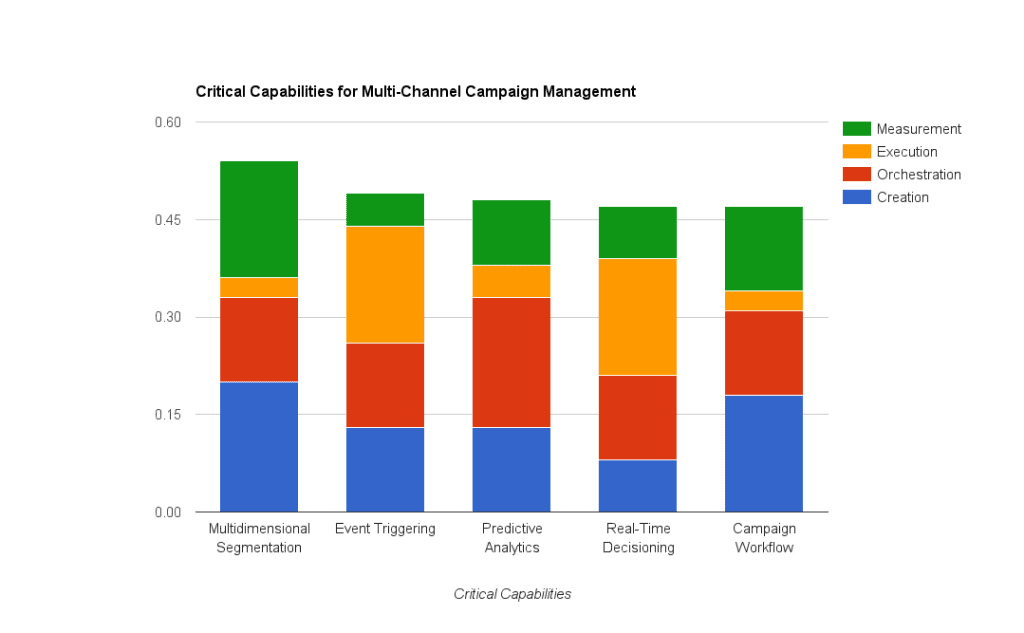 Understanding marketers’ key platform requirements provides insights into the future of marketing. After reading an Adobe Report on the evaluation criteria for multi-channel campaign management, it’s clear that marketers want to automate campaign creation. Adobe defines the stages of a marketing campaign as follows:
Understanding marketers’ key platform requirements provides insights into the future of marketing. After reading an Adobe Report on the evaluation criteria for multi-channel campaign management, it’s clear that marketers want to automate campaign creation. Adobe defines the stages of a marketing campaign as follows:
- Creation
- Orchestration
- Execution
- Measurement
[Tweet “Understanding marketers’ platform requirements is key. Here are 5 key capabilities for campaign management.”]
Adobe looked at the needs of marketers today and created a list of key platform capabilities and gave a score for the importance of each capability. To further refine the capability scoring, each capability was scored on its importance within the 4 stages of multi-channel campaign management. I took the scoring data Adobe provided and plotted it in the chart below to understand the most valuable capabilities for multi-channel campaign management.

Segmentation based on various buyer characteristics is the most important capability for marketers. Multidimensional segmentation is a clear front runner because of the trend towards increased personalization in marketing outreach. Traditional segmentation usually involves a single profile variable such as age. Multidimensional segmentation allows marketers to message consumers based on several variables at once. For example, a marketer could target women 18-25 who have purchased red shirts in the past 6-months and have a customer lifetime value over $500. For multidimensional segmentation to work, vendors must integrate various sales, marketing, and accounting systems, so data from each platform can be used effectively by marketers.
The next 4 critical components are all focused on automation and have roughly the same value. Below are the definitions for the top 5 most important capabilities for multi channel campaigns:
- Multidimensional Segmentation – This capability enables the grouping of audiences based on different attributes along multiple dimensions. Traditional attributes include products and likely buyers. Newer ones focus on potential profitability and the customer lifecycle using search, social and open graph data.
- Event Triggering – This capability enables marketers to automate the sending of an offer or promotion based on an action that an audience takes or something happening to it — for example, clicking on a particular Web page, abandoning a shopping cart or having a birthday.
- Predictive Analytics – This capability enables marketing analysts to create models that forecast demand, determine optimal campaign performance by adjusting parameters and run multidimensional scenarios, such as for a product launch.
- Real-Time Decisioning – This capability provides marketers with up-to-the-minute information and analytics that allow them to make timely choices about in-progress campaigns. For example, this function could identify which tweets the brand should immediately respond to during a social campaign.
- Campaign Workflow – This capability choreographs the work involved in designing and executing campaigns, including tasks, responsibilities and timelines.
Only a few years ago creating attractive emails and smart calls-to-action were capabilities reserved for enterprise companies with large marketing budgets. Now, gorgeous email templates, content creation and dynamic calls-to-action capabilities have vastly improved for most multi-channel marketing software vendors. Now that content creation is much easier, marketers can focus on increasing the conversion rate of existing content, offers, and campaigns. Another way to look at it is, the wealth of content that marketers have historically generated is not optimally used.
From my own experience here at Waterfall, increasing conversion rates through automation is hugely beneficial. Not only does it drive more leads, but where website data, or social media presence is sometimes difficult for people to grasp the direct value, increased conversion rates are not. The more people that convert, the more people sales comes in contact with. It’s a win-win!
Another reason for the push towards real-time responses and automated event triggering is that it’s too difficult to monitor all of the user communities existing across tons of channels. Marketers need a way to automate outreach and trigger their existing content based on a user’s interactions.
The findings of this report are not shocking but they do illuminate trends for marketers and hint to the future of marketing technology. The capabilities that are most important to marketers will impact a few changes in the way campaigns are designed:
- Bank of Offers: People will shift focus away from large promotional campaigns, and instead create a bank offers that are delivered to consumers based on how they interact with the brand
- Fewer Unprompted messages: Inbox overload and list decay due to oversharing is going to cause more marketers to send less messages unless the user has taken an action.
- Vendors will need predictive analytics: Platform providers have huge amounts of data on their clients campaign success and failures. They will soon be responsible for utilizing that data to inform their clients on best practices based on hard data.

